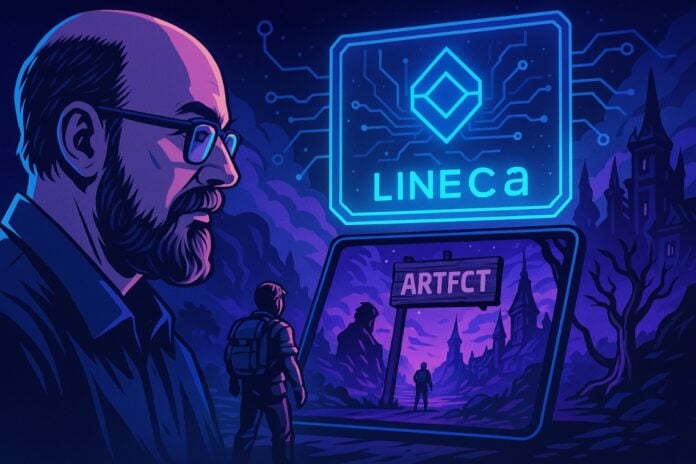Recently Lamina1, Neal Stephenson’s initiative, announces the integration with Linea, Consensys’s zkEVM network Consensys, to bring content and intellectual property on-chain on Ethereum.
The rollout begins with Spaces and with Artefact, a post-AI RPG created in collaboration with Weta Workshop, to offer creators greater control and direct access to the community.
According to data collected from official reports and network analysis, Linea has surpassed 230 million transactions and involved over 420 partner organizations by the end of 2024, figures that confirm the rapid adoption of the zkEVM rollup.
Industry analysts note that these indicators — along with the increasing use of verifiable attestations — make the potential for cultural and creative on-chain use cases more tangible.
Summary
What Changes: On-Chain Content and IP on Ethereum
The Lamina1–Linea agreement introduces native tools to publish stories, assets, and rights directly on the blockchain, aiming to reduce intermediaries, preserve authorship, and foster new forms of fan engagement.
In this context, the programmability of IP, licenses, and royalties makes the processes transparent and verifiable on‑chain, as reported.
Lamina1, launched in 2022, has attracted attention for more open cultural production models. The synergy with Linea aims to create an ecosystem where IP rights, licenses, and royalties are programmable and easily traceable.
Debut on Linea: Spaces and the Artefact Project
Spaces is the first environment released on Linea: a space dedicated to interactive narrative worlds directly governed by the creators. Here debuts Artefact, a role-playing game set in a post-AI world where players join factions, collect data fragments, and influence the storyline through on-chain actions.
It should be noted that the IP is being developed in collaboration with Weta Workshop and the Lamina1 team, with assets and progress recorded on Ethereum through Linea.
Why It Matters for Decentralized Storytelling
The combination of creativity and smart contracts enables participatory and traceable storytelling: creators can define rights from the conception of the work, manage versions and proof of authorship, as well as monetize independently without relying on centralized platforms.
With over 150,000 active addresses registered since launch, and with attestation systems on Linea that have already managed millions of credentials for various use cases, the interest in new production and distribution models is tangible.
Who’s Behind It: Investors and Infrastructure
- Investors: prominent figures such as Joe Lubin, co-founder of Ethereum and CEO of Consensys, and Systemic Ventures support the initiative.
- Layer‑2 Linea: a zkEVM rollup (zero‑knowledge Ethereum Virtual Machine) that scales Ethereum while maintaining compatibility with EVM tools. You can delve into the technical details in our articles on PancakeSwap extends its advanced trading features to Base, Arbitrum, and Linea and Arbitrum launches Onchain Labs to support emerging projects on Ethereum.
- Verax Attestations: a system of verifiable credentials that links identities, assets, and works to ensure traceability and security.
Technical Detail: zkEVM, ZK-proofs, and attestations
According to Consensys, Linea’s zkEVM offers fast blockspace, reduced costs, and full compatibility with existing smart contracts, allowing seamless integration with Ethereum. The ZK‑proofs (zero-knowledge proofs) ensure rapid finality and security by publishing the proofs on Ethereum, as confirmed by Ethereum.org.
Verax allows the association of verifiable attestations with users, NFTs, and content, enabling on-chain reputation, provenance traceability, and digital rights management, thus reducing ambiguities related to authorship, licensing, and commercial use.
In-depth: what is a zkEVM and how does a ZK-rollup work on Ethereum? Check the technical guide on Ethereum.org.
Ownership and Monetization Without Intermediaries
Lamina1 introduces innovative mechanics for ownership rights and programmable monetization: through the use of attestations to establish authorship, the sale of native assets, and co-creation governed by smart contracts, creators maintain full control of their IP.
That said, they will be able to define royalties and terms of use, involving the community in narrative voting and spin-offs, with transparency made possible by on-chain traceability.
Quick Guide: Creating On-Chain Content
- Choose the network: use an EVM-compatible L2, such as Linea, to benefit from significantly lower costs and finality compared to Ethereum L1.
- Register the IP: adopt verifiable attestations to document authorship, contributions, and versions of the work.
- Tokenize assets: define standards (NFT, SFT) and the rights associated with each narrative object.
- Monetize: set royalties, licenses, and exclusive benefits for holders, such as access, votes, and extra content.
- Measure: tracks on-chain engagement through attestations, missions, and progress related to history.
Debate on the LINEA token and community reactions
The recent Token Generation Event (TGE) of Linea has reignited the debate on the utility of the token. Joe Lubin, in a post on X @ethereumjoseph, suggested that long-term holders might benefit from future initiatives, while part of the community is calling for concrete features such as staking or direct integration into the ecosystem.
Some observers have even speculated a drift towards a “memecoin” if the token does not find a clear role in security, fee payment, or governance, highlighting how economic sustainability will depend on the real adoption of applications like Artefact and incentives for creators and players.
Operational FAQ and Roadmap
- On-chain history protection: yes, thanks to smart contracts and attestations that define authorship, licenses, and royalties.
- Required skills: no-code tools lower the entry barrier, while for advanced cases the development of smart contracts is necessary.
- Costs: the fees on L2 are lower compared to Ethereum L1, although the amount varies based on congestion and transaction complexity.
- Rollout timing: Spaces is already being rolled out on Linea, while additional features are planned in progressive updates.
- Artefact Roadmap: an expansion of factions, assets, and on-chain missions is planned; official details are forthcoming.
- Tokenomics and ownership: the rights remain the property of the creators as defined by the smart contracts; any game tokens must specify their utility and the rules of issuance.
- Where to get information: you can visit the official websites of Linea, Consensys, and Lamina1.
In summary
The partnership between Lamina1 and Linea opens a new programmable scenario for stories, assets, and rights on Ethereum. If Spaces and Artefact can scale significantly, we may witness the emergence of a new standard for interactive storytelling, where fans and creators co-construct worlds with clear, transparent, and verifiable rules.
Note: some details, such as the joint official statement from Lamina1/Linea, the project page of Artefact, and a direct statement from Declan Fox, are pending official confirmation and will be updated as soon as available.


